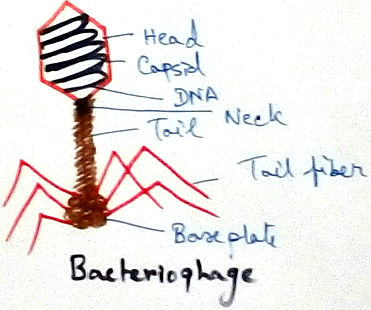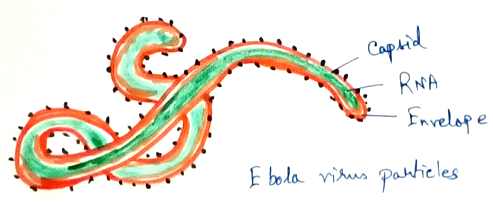Virus
Element which is between the state of living and nonliving, a cellular, disease producing, parasitic in nature, living state is observed only within living cell and able to reproduce only within living cell is called virus.
Structure of virus- According to shape virus can be of different shape. Those are spherical (polio virus), rodshaped (TMV), ovoid (influenza virus), cuboidal (Variola virus), spermatozoa shaped (bacteriophage).
One entire virus molecule is known as virion. Entire virus body can be divided into
1. Capsid,
2. Virus genome.
1. Capsid: Outer most covering of virus is known as capsid. It consists of capsomere, which is the subunit of capsid. Virus may covered with capsid or may be without capsid. Capsids are mainly made up of proteins, nut in some cases other materials like carbohydrate (TMV), fat and starch (Influenza virus), protein (vaccinia virus), lysozyme (bacteriophage), neuraminidase (Influenza virus).
Virus without capsid are called Lipo virus (Harpies virus.). Subunit of capsid is pelpomere. In some cases spike are observed which is made up of haemaglutinin and acts as antigen. When it enters the host body, it converts the RBC into mass. Viruses without capsid are called viriod. Here envelope is observed.
2. Nucleoid- This is consist of nucleic acid which is covered by capsid.Virus contains DNA or RNA or both DNA and RNA.
Bacteriophage has a special type of structure. It can be divided into different parts. They are head, neck, tail, end plate. First it injects genetic material into host body .There it proliferateto give rise in number.
Reproductive materials of different virus are-
1. DNA- here genetic material is DNA. DNA virus can be two types according to the presence of number of strand.
Single stranded- Gemini virus.
Double stranded- Variola virus.
2. RNA - here genetic material is RNA. According to presence of strand RNA virus can be two type-
Single stranded- Tobacco mosaic virus (TMV)
Double stranded- Rio virus.
3. DNA and RNA – initially the genetic material is RNA but when virus entered the living cell, RNA is converted into DNA by reverse transcriptase enzyme. E.g. Ross sarcoma.
Generally animal disease producing virus are DNA virus and plant disease producing virus are plant virus.
Virus living or nonliving?
In virus both characteristics of living and nonliving are observed.
Nonliving Characteristics of virus are-
(i) Do not contain any cytoplasm.
(ii) Unable to respond to any external stimulus.
(iii) cellular metabolism is absent in virus.
(iv) Virus don’t have any locomotion.
(v) They cannot reproduce outside the living cell.
Living characteristics of virus-
(i) Virus contains nucleic acid and protein.
(ii) Virus is able to reproduce in a living cell.
Four common diseases caused by virus –
Small pox - small pox spreads from oral, nasal, vesicular discharges, pustules and scabs. Brick shaped DNA virus Variola virus causes this diseases.
Measles - this disease caused by RNA containing virus called Rubella virus or Polynosa morbillorum.
Polio - polio- is caused RNA virus called Polio- virus.
Influenza– influenza is caused by Myxovirus influenza.
Questions and answers on Virus:
1. What is bacteriophage?
Virus that attack bacteria are called bacteriophage.
2. What is actinophage?
Virus that attack actinomycetes are called actinophage.
Recent Articles
-
Explain about Growth in Plants |Definition of Growth & Differentiation
Feb 27, 25 02:07 PM
Growth is a permanent increase in length or volume of an organism that brought upon by an increase in its dimensions due to synthesis of new protoplasmic material. -
Definition of Respiratory Quotient | calculation | Application | Plant
Dec 02, 24 12:09 AM
Definition of respiration quotient- the ratio of the carbon-dioxide evolved to that of the oxygen consumed by a cell, tissue, plants or animals in a given time is called respiratory quotient. It is us… -
Amphibolic Pathway | Definition | Examples | Pentose Phosphate Pathway
Jun 06, 24 10:40 AM
Definition of amphibolic pathway- Amphibolic pathway is a biochemical pathway where anabolism and catabolism are both combined together. Examples of amphibolic pathway- there are different biochemical… -
Respiratory Balance Sheet | TCA Cycle | ATP Consumption Process
Feb 18, 24 01:56 PM
The major component that produced during the photosynthesis is Glucose which is further metabolised by the different metabolic pathways like glycolysis, Krebs cycle, TCA cycle and produces energy whic… -
Electron Transport System and Oxidative Phosphorylation | ETC |Diagram
Feb 04, 24 01:57 PM
It is also called ETC. Electron transfer means the process where one electron relocates from one atom to the other atom. Definition of electron transport chain - The biological process where a chains…






New! Comments
Have your say about what you just read! Leave me a comment in the box below.